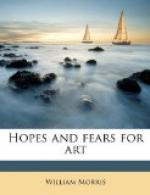All which I neither praise nor blame, but say that so it is: some people praise this homeliness overmuch, as if the land were the very axle-tree of the world; so do not I, nor any unblinded by pride in themselves and all that belongs to them: others there are who scorn it and the tameness of it: not I any the more: though it would indeed be hard if there were nothing else in the world, no wonders, no terrors, no unspeakable beauties: yet when we think what a small part of the world’s history, past, present, and to come, is this land we live in, and how much smaller still in the history of the arts, and yet how our forefathers clung to it, and with what care and pains they adorned it, this unromantic, uneventful-looking land of England, surely by this too our hearts may be touched, and our hope quickened.
For as was the land, such was the art of it while folk yet troubled themselves about such things; it strove little to impress people either by pomp or ingenuity: not unseldom it fell into commonplace, rarely it rose into majesty; yet was it never oppressive, never a slave’s nightmare nor an insolent boast: and at its best it had an inventiveness, an individuality that grander styles have never overpassed: its best too, and that was in its very heart, was given as freely to the yeoman’s house, and the humble village church, as to the lord’s palace or the mighty cathedral: never coarse, though often rude enough, sweet, natural and unaffected, an art of peasants rather than of merchant-princes or courtiers, it must be a hard heart, I think, that does not love it: whether a man has been born among it like ourselves, or has come wonderingly on its simplicity from all the grandeur over-seas. A peasant art, I say, and it clung fast to the life of the people, and still lived among the cottagers and yeomen in many parts of the country while the big houses were being built ‘French and fine’: still lived also in many a quaint pattern of loom and printing-block, and embroiderer’s needle, while over-seas stupid pomp had extinguished all nature and freedom, and art was become, in France especially, the mere expression of that successful and exultant rascality, which in the flesh no long time afterwards went down into the pit for ever.




